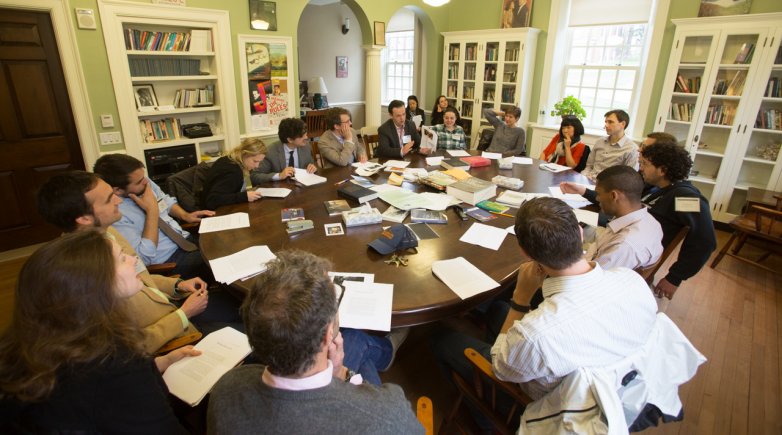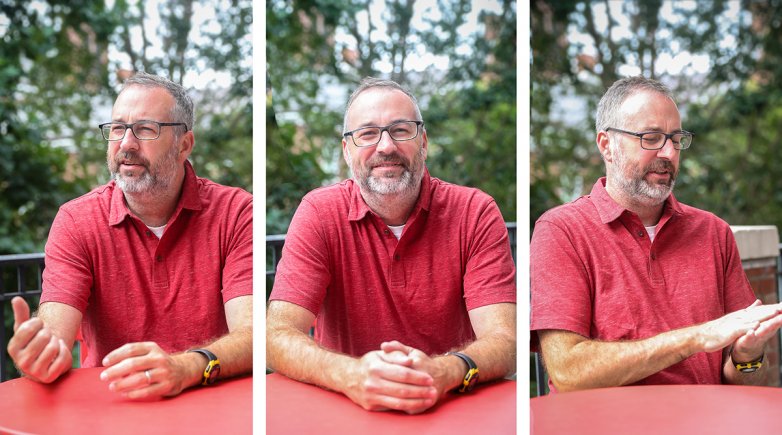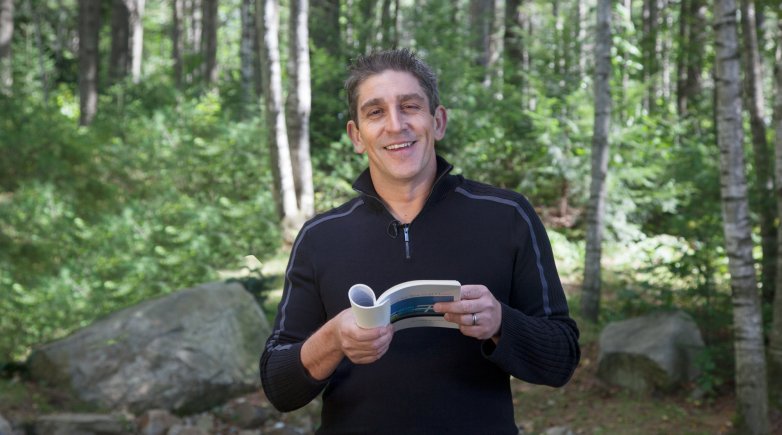How do you orient new Exeter teachers to Harkness? Take them straight to the table.
New faculty start with a Harkness conversation with experienced instructors.
On a morning in late August, the very large Harkness table in a conference room in Phelps Science Center is, in many ways, breaking Harkness rules. Twenty-two people are seated around it, not the standard 12. They are all adults, mostly new faculty, gathered for the introductory session of a daylong orientation to Harkness Teaching and Learning.
All are here to learn about what Bates-Russell Distinguished Faculty Professor Meg Foley, who leads this discussion, calls “the numerous techniques and little bit of magic” that make Exeter’s student-centered, discussion-based approach so effective.
The faces around the table show excitement as Foley tees up a series of videos taken in actual Harkness classes. After each, Foley asks the new faculty, who will soon be teaching in a broad range of departments (History, Math, Music, Modern Languages, Theater and Dance), to make observations.
One participant remarks on the vulnerability the students show as they work together to solve problems in a math video. “I see real confidence in them,” she says.
“It’s not the most efficient way to get to the answer,” remarks Jerome Walker, a new teaching intern in Music, shining an interesting light on Harkness.
“Math can get messy!” adds Javier Alvarez, who, with 20 years of math teaching experience at independent schools, will soon be leading math classes at Exeter.
“That’s true of every class,” affirms Dean of Faculty Ellen Wolff. “They’re all messy.”
As the new faculty continue to watch, comment and absorb, Foley and Wolff interject brief highlights from their years of teaching at Exeter, Wolff in English and Foley in both history and economics.
Wolff: "As a teacher, you have to work to build a trusting community."
Foley: "You’re constantly asking yourself, is everybody OK? You do everything you can to let the students know you care. To build trust."
Wolff: "That is the great challenge with ninth graders. All their lives they have had the right answers. With Harkness, they learn to bring the right questions."
Getting to the table
By the time English Instructor Ellee Dean’s class starts in early afternoon, the new faculty participants are showing signs of comfort with each other and the process. This group (the full set was split into two smaller sections for Harkness classes) has already presented and discussed problems in a class led by Math Instructor Laura Marshall. They are bonding. The humidity is rising outside, a reminder that it is still very much high summer, but the classroom in Phillips Hall is pleasantly cool.
Dean’s introductory exercise, which involves pairs of teachers using eye contact and tone of voice to express themselves (with a vocabulary limited literally to “one,” “two,” and “three”), elicits gales of laughter. As they dive in to the texts — a short nonfiction piece by Karen Russell and a poem by Natasha Trethewey — the new faculty are in full Harkness rhythm. They have fun taking turns as they read the texts out loud. Conversation moves fluidly across the table, with universal participation. Everyone listens intently. People build on observations by others.
After about 30 minutes of discussion, Dean congratulates her new colleagues on what they have covered: tone, juxtaposition, pace, setting, feel. Several participants who had been leaning into the table during the discussion relax back into their chairs.
“What’s on your mind?” Dean asks quietly as she, too, leans back. A short silence (the first in this class) is followed by questions. “Do you often do cold readings?” “Are students anxious about reading out loud?” “What do you do when you see someone struggling?”
As the English class breaks up, these new Exeter faculty, who have now experienced working with peers at the Harkness table to discuss both math and literature, linger a bit. They do what Exeter students often do at the end of class: they pull their stuff together in bags or knapsacks, they chat in small groups. And some stay behind to connect with the teacher.


